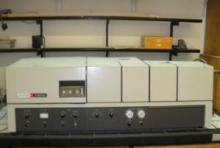The spectrophotometer is an instrument which measures the amount of light of a specificed wavelength which passes through a medium. According to Beer's law, the amount of light absorbed by a medium is proportional to the concentration of the absorbing material or solute present. Thus the concentration of a colored solute in a solution may be determined in the lab by measuring the absorbency of light at a given wavelength. Wavelength is measured in nm. The spectrophotometer allows selection of a wavelength pass through the solution. Usually, the wavelength chosen which corresponds to the absorption maximum of the solute. Absorbency is indicated with a capital A. At the spectrophotometer, you should have two cuvettes in a plastic rack. Solutions which are to be read are poured into cuvettes which are inserted into the machine. One should be marked "B"for the blank and one "S" for your sample. A wipette should be available to polish them before insertion into the cuvette chamber. Cuvettes are carefully manufactured for their optical uniformity and are quite expensive. They should be handled with care so that they do not get scratched, and stored separate from standard test tubes. Try not to touch them except at the top of the tube to prevent finger smudges which alter the reading. For experiments in which minor inprecision is acceptible, clean, unscratched 13 x 100 mm test tubes may be used.

